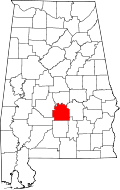Civil Rights Era and "Bloody Lowndes" (1965)
Despite the county's black majority, it had no registered black voters in the spring of 1965, after more than 60 years of disenfranchisement under the Alabama Constitution. Civil rights activists worked in Hayneville and Lowndes to organize residents in preparation for registration and voting. After passage of the federal Voting Rights Act of 1965 in August, activists provided residents with political education and helped them register to vote. They continued to work to integrate stores and public facilities. On August 13, 1965, Jonathan Daniels, an Episcopal seminarian from New Hampshire, worked with a group of 29 civil rights protesters to picket whites-only stores in the small town of Fort Deposit. All of the protesters were arrested by county police and taken to jail in nearby Hayneville. Five juvenile protesters were released the next day. The rest of the group was held for six days; they refused to accept bail unless everyone was bailed.
On August 20, the prisoners were released without transport back to Fort Deposit, and after release, the group waited by a road nearby the jail. Daniels, along with three others — a white Catholic priest and two black women activists—went to buy soft drinks at Varner's Grocery Store, one of the few local stores that would serve non-whites. There, they encountered Tom L. Coleman, an engineer for the state highway department and unpaid special county deputy wielding a shotgun. The man threatened the group, and finally leveled his gun at seventeen-year-old Ruby Sales. Daniels pushed Sales to the ground and caught the full blast of the gun, which killed him instantly. Father Richard F. Morrisroe grabbed the other protester and ran. Coleman shot Morrisroe, wounding him in the lower back. [7] White resistance to civil rights organizers continued.
In June 1965, Gregory Orr, a student from upstate New York who traveled to Mississippi to take part in civil rights protests, was driving home from the capital of Jackson. He had been arrested there with other protesters and held without charges for 10 days at the state fairgrounds. While driving through Lowndes County, he was stopped by white vigilantes, kidnapped and held without charges for eight days in the Hayneville courthouse jail. Back in New York that August, Orr read a report of the murder of Jonathan Daniels in The New York Times. [7] He recognized one of his kidnappers in a photograph—apparently Tom Coleman. [8] Numerous other incidents have been documented in the county of violence against civil rights people.
Civil rights activities in Lowndes continued in the county under the leadership of Stokeley Carmichael, the Student Nonviolent Coordinating Committee (SNCC) and local residents, to educate and register blacks to vote after passage of the Voting Rights Act of 1965. They organized the Lowndes County Freedom Organization (LFCO), the first independent black political party in the county since Reconstruction era, and continued to register voters. They ran a slate of candidates in 1966 but lost due to election fraud in the majority-black county. In 1970, African-American chairman of LCFO John Hulett was elected as county sheriff.
Incorporation (1967-1968)
The incorporation of Hayneville as a town began in July 1967 with the vision of 25 qualified electors of the county and residents of the Hayneville community. Two subsequent attempts were made for incorporation, the last resulting in favor of incorporation. Only one person filed for a statement of candidacy and was nominated for the office of Mayor and five places on the town council. Therefore, due to the completion of the requirements of incorporation, the court declared on July 15, 1968, by Probate Judge Harold Hammond, that Hayneville was completely incorporated.





